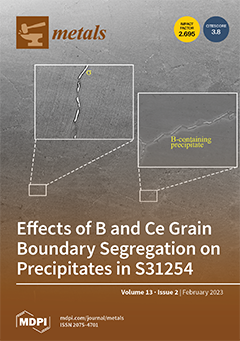To improve the yield of titanium alloy, a certain amount of TiO
2 can be added to the refining slag system of Ti-bearing steel grades. With the aim of understanding the effect of TiO
2 addition on the melting behaviors of CaO-SiO
2
[...] Read more.
To improve the yield of titanium alloy, a certain amount of TiO
2 can be added to the refining slag system of Ti-bearing steel grades. With the aim of understanding the effect of TiO
2 addition on the melting behaviors of CaO-SiO
2-30%Al
2O
3-5%MgO refining slags, the melting points of the slags and the phases in the slags are herein studied at different temperatures in the laboratory. It is found that with the increase in TiO
2 content (0~10%) in slag, the melting point of the slags drops first, and then rises. The effect of slag basicity (
R =
w(CaO)/
w(SiO
2), 2~10) shows a similar tendency. The TiO
2 content and slag basicity evidently affect the precipitated phases in the slags at a lower temperature (e.g., 1310 °C). With the increase in basicity, the liquid areal fraction increases first, and then decreases. Moreover, the CaO-TiO
x-Al
2O
3 phase (CTA) and its TiO
x content show a declining trend at 1310 °C. When
R = 10, large amounts of solid calcium aluminates are precipitated. With TiO
2 addition in the slags, the TiO
x contents in both liquid and CTA phases increase. Excessive TiO
2 addition (e.g., 10%) leads to the large precipitation of CTA, as well. To improve the melting properties of the slag and the yield of Ti alloys during the refinement of Ti-bearing steel grades, a small TiO
2 addition (e.g., 5%) may be considered.
Full article





